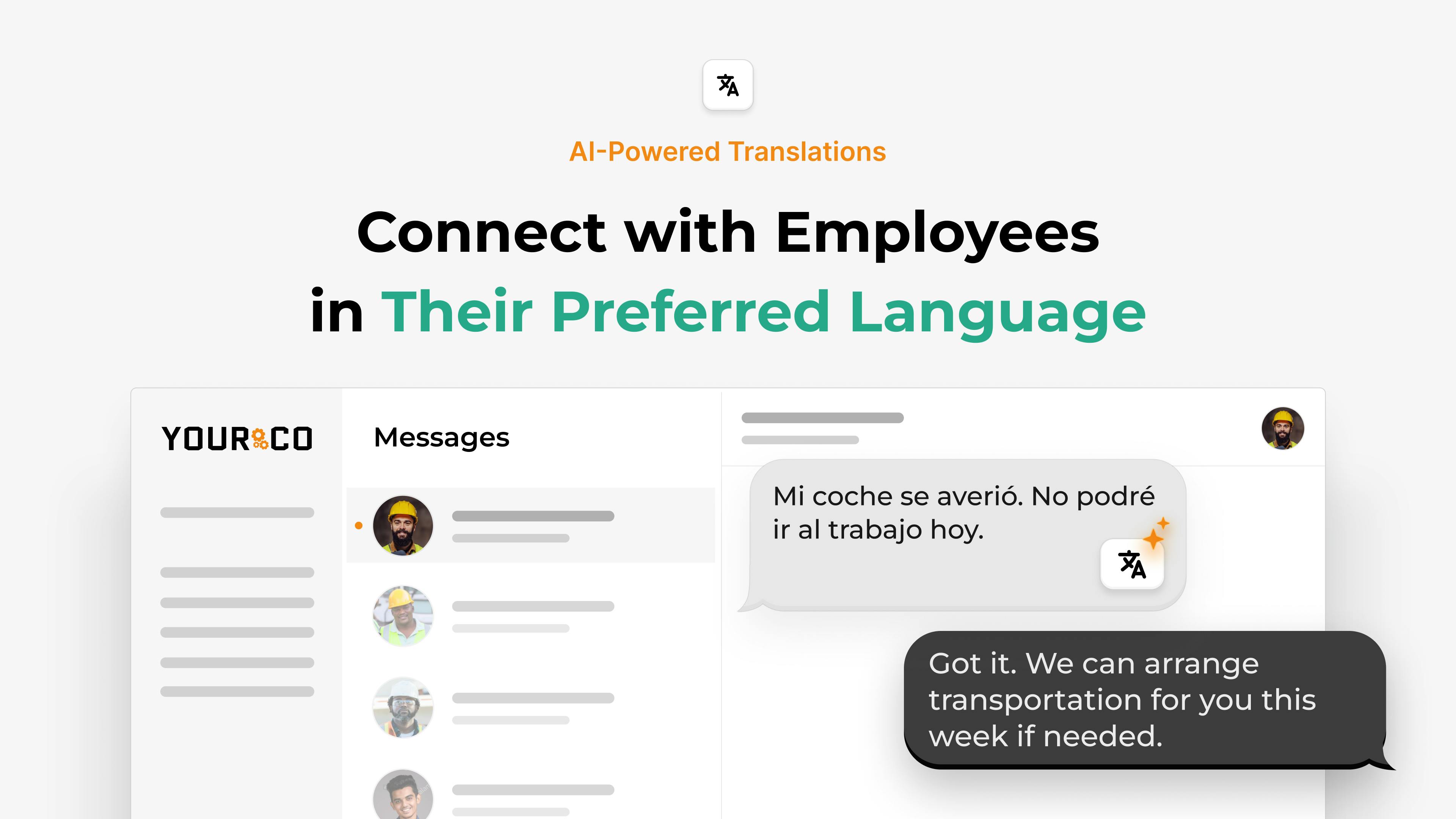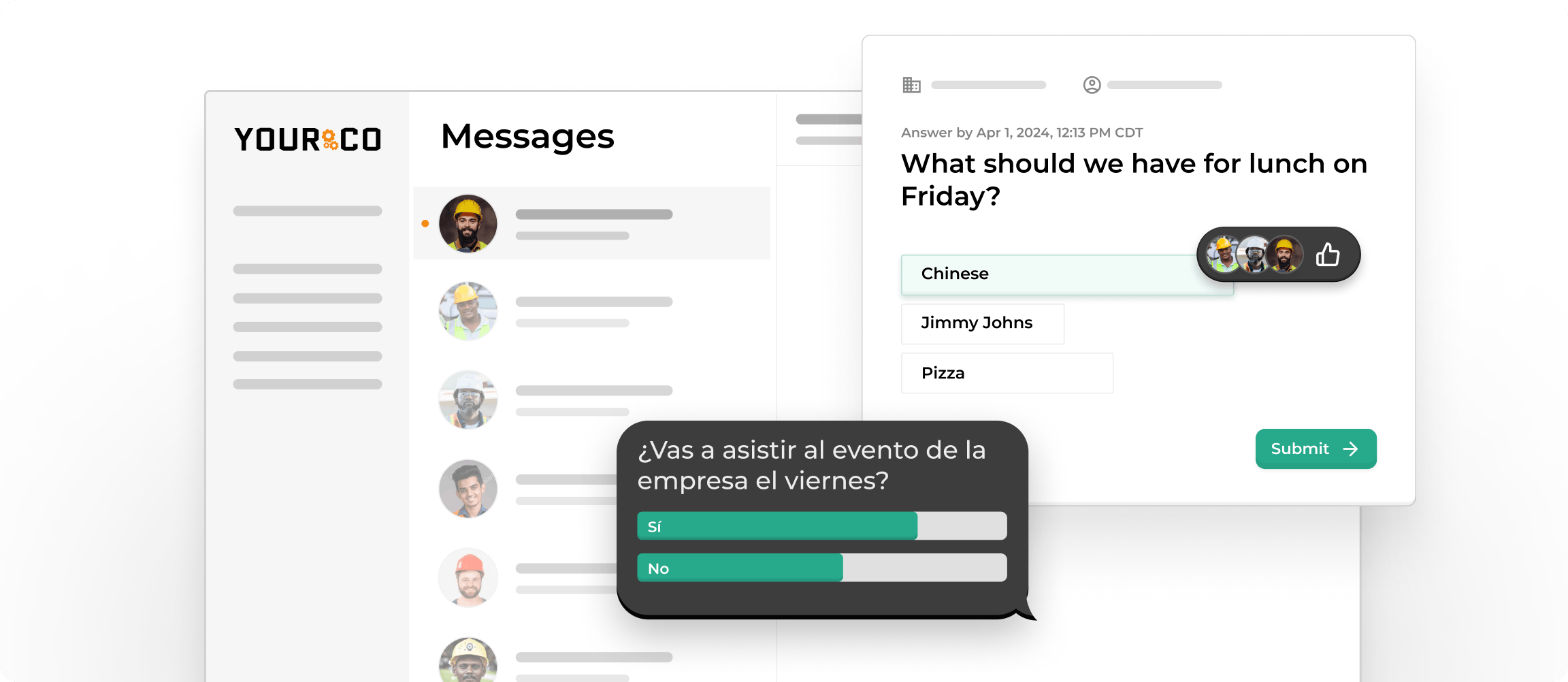Best Onboarding Checklist for Tagalog Workers


The first days on a new job leave a lasting impression. For Tagalog-speaking employees, those days set the tone for how safe, supported, and connected they feel at work. A thoughtful process matters because language and culture shape how people take in information, ask questions, and build trust with their team.
When onboarding is rushed or unclear, small misunderstandings can grow into bigger issues. But when it is planned with care, new hires quickly learn their role, feel welcomed by colleagues, and gain the confidence to do their best work. This checklist gives you a clear path to prepare, guide, and support Tagalog-speaking employees so they can thrive from day one and stay engaged for the long run.
Prepare Everything Before Day One
Get the basics right and your Tagalog-speaking hires will walk in feeling informed, respected, and ready to work. Before anyone clocks in, focus on four things:
- Translate the important paperwork
- Prepare bilingual resources
- Set up a mentor
- Send a warm (SMS) welcome
Translate Critical Documents Professionally
Start with the documents that matter most. Contracts, safety manuals, Personal Protective Equipment (PPE) guides, and benefits forms all need professional translation. Work with qualified translators who know your industry and local labor rules, then have legal counsel review the Tagalog version.
Put a simple one-page Tagalog summary at the front of each packet that covers wages, hours, and key safety rules. Workers will read this quick reference.
Create Accessible Orientation Materials
Create handouts that new hires can follow. Your orientation materials should be accessible and practical in both languages:
- Orientation slides, site maps, and emergency contacts in English and Tagalog
- PPE checklists and locker rules with visual icons
- Digital PDFs for phones and sturdy printouts for factory floors
- Pocket cards of common safety phrases for easy reference
These materials show you care about making things easier.
Assign Culturally Aware Mentors
Pair each hire with someone who speaks both the job and the culture. Find a peer-level buddy who's fluent in Tagalog and comfortable explaining how things work. Look for patience, good attendance, and genuine enthusiasm. Formal supervisor programs can feel intimidating, but a friendly coworker makes it easier to ask questions.
Brief mentors on cultural norms, such as indirect feedback, respect for hierarchy, and family focus, and then schedule check-ins on day one, day three, and day five. Well-structured mentor programs help people get up to speed faster and stick around longer.
Send a Welcoming SMS Introduction
Start the relationship with a text. Most workers read texts within minutes, so SMS beats email for first contact. Keep it short, polite, and helpful:
"Kamusta, [Name]! Maligayang pagdating sa [Company]. Pumasok sa Gate 2 bukas, 7:45 AM. Dalhin ang isang valid ID. May libreng agahan. Kita kita!"
A message like this, sent through an SMS platform, answers basic questions, uses friendly language, and shows respect by opening with "Kamusta" and "Maligayang pagdating." It also sets the tone: you communicate in the language they trust.
When you translate the right documents, stock bilingual materials, connect people with culturally aware mentors, and send a thoughtful welcome text, you clear away uncertainty before day one even begins. Workers arrive confident, and you start building trust from the very first ''hello''.
Execute Your First Day Welcome Plan
A well-planned first day gives Tagalog-speaking hires instant confidence and shows that you respect both their language and culture. Set the tone with clear communication, visible support, and hands-on learning that feels welcoming rather than overwhelming.
Start With a Warm Greeting
Start with a genuine "Kumusta?" and a smile. Simple greetings tell new teammates you value their identity and effort. Arrange introductions in a group setting so everyone can greet the newcomer together. This mirrors the Filipino emphasis on community and avoids putting the employee on the spot.
Encourage colleagues to share their job roles and offer help, then close with a respectful nod or handshake.
Provide a Bilingual Welcome Packet
Hand over a bilingual welcome packet right after introductions so there's no gap between greeting and guidance. Your welcome packet should include:
- A brief letter in English and Tagalog explaining your mission
- A glossary of industry terms in both languages
- Maps of the facility and emergency exits
- Phone numbers for human resources (HR) and mentors
- One-page outline of family-oriented benefits and wage schedules
This mix of practical and family-focused information reflects Filipino priorities around safety and kinship.
Explain Company Culture Clearly
Speak plainly about company culture next. Tie core values like teamwork, initiative, and safety to familiar Filipino concepts such as pakikisama (harmony) and malasakit (care). Clarify reporting lines early, as many Filipino employees defer to authority; naming decision-makers helps them navigate the hierarchy without guesswork.
Address feedback norms too: invite questions and explain that candid input is encouraged, even if indirect communication feels more natural.
Demonstrate and Teach Job Duties
Move from talk to action with a hands-on walkthrough of job duties. Demonstrate each step, then ask the employee to repeat it while you observe. Visual aids, color-coded labels, and short video clips reduce language strain. Use teach-back phrases like "Pakita mo nga ulit" ("Show me again") so you can confirm understanding without making the person feel tested.
Break complex tasks into smaller chunks, celebrate each successful run-through with a quick "Ayos!" (All good), and end the shift with a friendly check-in. This blend of respect, clarity, and encouragement turns day one into a strong foundation for everything that follows.
Deliver Effective First Week Training
Building on the positive momentum from day one, the first week requires focused attention on safety training, regular communication, clear benefit explanations, and feedback collection. Each element helps reinforce what employees learned initially while addressing new questions that arise.
Prioritize Safety Training in Tagalog
Deliver safety information in Tagalog to ensure clear understanding and compliance among new employees. Use bilingual signage and visual safety cues that transcend language barriers. Conduct hands-on demonstrations using safety equipment, allowing employees to engage directly with materials and processes.
Send SMS reminders for key safety protocols to reinforce retention. Use confirmation mechanisms like acknowledgment receipts or brief quizzes to ensure that safety instructions are not only received but understood.
Establish Daily Check-Ins
Establish a structure for effective daily check-ins with your Tagalog-speaking employees. These sessions should foster open communication, respecting cultural sensitivities by using simple phrases. Questions like "Kumusta ka na?" (How are you?) can bridge trust. Creating psychological safety during these interactions encourages employees to voice concerns without fear, promoting a supportive environment.
Explain Wages and Benefits Clearly
Discuss wages and benefits using a culturally aware approach. Visual aids are invaluable in making complex benefits information easily digestible, especially when placed in a culturally relevant context. Highlight family-oriented benefits that align with Filipino values and reinforce inclusivity. When explaining these details, maintain a balance of transparency and formality to respect cultural nuances.
Collect and Act on Feedback
Actively seek feedback to improve your process, but do so respectfully. Use SMS surveys in Tagalog to gather genuine insights. To overcome cultural hesitance, provide channels for anonymous feedback. Recognize those who offer constructive input to encourage participation. Act on feedback promptly, as this demonstrates respect and builds trust, showing your commitment to continuous improvement.
Build Long-Term Success In 30 Days
The first month determines whether Tagalog-speaking employees feel comfortable and stay productive. Regular check-ins, clear expectations, and culturally aware recognition help new hires succeed while reducing early turnover.
Schedule two formal conversations: one after the first week, another at day 30. Start each meeting with "Kumusta ka na?" to create a welcoming atmosphere and encourage honest feedback. Keep these meetings focused but relaxed by covering these key areas:
- How daily tasks match what they expected
- Confirming safety understanding by having them explain key procedures back to you
- Addressing any challenges with equipment, schedules, or teammates
- Pointing out one thing they're doing well
- Setting a learning goal for the next few weeks
Write down what you discuss so you can spot patterns and follow up on concerns.
Between meetings, send quick SMS surveys to track how things are going. Text messages reach nearly all recipients, much higher than email open rates. Keep questions simple and offer both languages: "Naiintindihan mo ba ang safety steps? Reply 1-Hindi, 2-Bahagya, 3-Oo." Weekly response patterns help you catch bigger problems early, like unclear training materials or equipment issues affecting multiple people.
Celebrate early wins the way Filipino culture appreciates: together as a team. A shared lunch or team-wide thank-you text works better than individual awards. Be specific about what the team accomplished: "Salamat sa inyong lahat for finishing the first production run with zero defects."
Keep learning going with short training delivered through SMS links. Workers can watch short videos or review picture guides during breaks without downloading apps. Follow each lesson with a quick quiz and mentor discussion.
Combining regular check-ins, mobile-friendly surveys, team-focused recognition, and ongoing micro-learning gives Tagalog-speaking employees the foundation they need to succeed long-term.
Maintain Strong Ongoing Engagement
Staying connected after the first month comes down to four simple habits: send regular Tagalog updates, respect Filipino culture, recognize effort the right way, and keep feedback flowing both ways.
Send Regular Updates In Tagalog
Set up a simple routine: send a quick shift reminder the night before, provide a weekly summary every Friday, and deliver immediate alerts when anything important changes. Start each message with a friendly "Magandang araw, [Name]" and end with "Salamat po." These small touches show respect and keep conversations warm. When a message only applies to certain roles or locations, target those specific groups so people don't start ignoring your texts.
Respect Cultural Traditions
Culture matters when you recognize events that bring Filipinos together. Your team will appreciate it when you acknowledge Independence Day (June 12), Christmas, and "Buwan ng Wika," when language pride runs high. A potluck lunch or quick trivia contest costs little but shows you value community.
Recognize Teams, Not Just Individuals
Recognition hits differently when you focus on the group instead of individuals. Open competitions can backfire since Filipino employees often see them as disruptive to team harmony. Instead, celebrate crews that meet safety goals or handle rush orders together. Thank the entire team publicly: "Salamat sa malasakit, Team A!". When you can afford it, offer family-friendly rewards like grocery vouchers.
Keep Feedback Flowing Both Ways
Keep conversations going with simple check-ins. A quick "Kumusta ka?" survey every two weeks gets honest feedback without putting anyone on the spot. Use a 1-to-5 scale to keep it simple: "Paki-rate ang trabaho ngayong linggo, 1 (hindi maayos) hanggang 5 (napakaganda)."
Two-way SMS lets workers respond in Tagalog, which removes barriers that hierarchy and hiya often create. Act on what you learn quickly, and always share results; nothing kills trust faster than ignored feedback. When you stay connected through their preferred language, momentum from the initial process becomes lasting engagement.
Transform Your Tagalog Onboarding With Yourco
Traditional onboarding methods fail Tagalog-speaking workers who rarely use email, face spotty Wi-Fi, or lose printed packets. Yourco solves these challenges with purpose-built SMS communication that reaches every employee instantly, regardless of their device or internet access.
Yourco automatically translates your onboarding messages into Tagalog using AI-powered technology that understands workplace terminology. Send first-day directions, safety video links, or document reminders with confidence that every word reaches employees in their preferred language. Real-time delivery means fewer no-shows and clearer daily communications when schedules change last minute.
Yourco's built-in polling and survey features make collecting feedback simple. Quick "Kumusta ka?" check-ins in Tagalog build trust, while automated insights help you spot patterns and improve your process.
With 240+ HR Information Systems (HRIS) and payroll integrations, your new hire data syncs seamlessly. Enterprise-grade security protects sensitive documents, while unlimited messaging ensures you never run out of communication capacity during busy hiring periods.
Try Yourco for free today or schedule a demo and see the difference the right workplace communication solution can make in your company.
Frequently Asked Questions
Why is bilingual onboarding important for Tagalog-speaking workers?
When you provide key materials and training in both English and Tagalog, new hires grasp rules, safety steps, and wage details right away. Clear language prevents mistakes, gets people productive faster, and shows respect for their background, which keeps them engaged and more likely to stay. Simple phrases from managers go a long way in building trust.
How can HR make sure translated documents are accurate?
Start with a professional translator who understands your industry. Give them glossaries of key terms and have a bilingual reviewer check legal sections. For contracts or safety manuals, get a quick legal review before sharing with employees.
What role does SMS play in reaching non-desk employees?
Texts reach almost everyone, usually within minutes. This makes SMS perfect for first-day directions, safety reminders, or quick surveys. Workers don't need Wi-Fi or downloads, so you can connect with everyone fast.
How often should HR check in with Tagalog hires during the process?
Plan quick daily check-ins for the first week, then meet at day 7 and day 30 to talk about how things are going. Regular touchpoints work well. Keep questions open-ended and try Tagalog greetings like "Kumusta ka?" to encourage honest feedback.
How can cultural recognition improve retention for Tagalog workers?
Filipino teams value group harmony and family connections. Celebrate shared wins, mention individual effort within the team context, and acknowledge events like National Heroes Day or Christmas parties. Programs focused on collective success work better than competition. Simple gestures, such as a group lunch after hitting a milestone, often mean more than formal awards.





